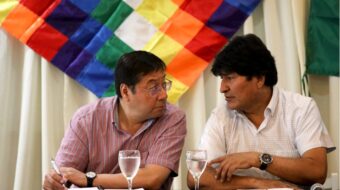
CHICAGO — The Mexican Fine Arts Museum is revealing the missing chapter in Mexican history with a groundbreaking exhibition. “The African Presence in Mexico: From Yanga to the Present” showcases the past 500 years alongside two other companion exhibits: “Roots, Resistance and Recognition,” and “Common Goals, Common Struggles and Common Ground.”
The project provides an opportunity for African Americans and Mexicans to embrace a common cultural past, allowing the rest of American society to have a better understanding of the complexity of race issues that face both the U.S. and Mexico.
“The African Presence in Mexico project is the most important cultural presentation ever organized by the Mexican Fine Arts Center Museum,” said Carlos Tortolero, president of the Mexican Fine Arts Center Museum. The exhibit “demonstrates a dynamic cultural connection between Mexicans and African Americans, the two largest cultural groups in Chicago,” he said.
Aquilina Carranza, a college student at the exhibit, summed up its impact. “I’m really glad people are finally getting to know about the Afro-Latino culture. It helps us branch out. There is a lot of segregation and we need to focus on the beauty of bringing us all together.”
Africans in Mexico
While just under 2 percent of the population in Mexico was enslaved Africans, they had a huge presence in colonial Mexico (1521-1810) working as domestic servants, day laborers, cattle ranchers, artisans, farmhands and miners on haciendas (large plantation estates). Africans worked in the sugar and silver industries helping to establish Mexico City and many other cities and towns throughout Mexico.
The contribution of Africans is seen throughout Mexican history and culture, from the struggles to abolish slavery to the Mexican Revolution.
Runaway slaves were called cimarrones by the Spanish. They lived in fortified settlements called palenques, which were used as bases, living quarters, meeting places and centers to attract rebels. Well organized, the former slaves conducted surprise attacks on the Spanish ruling class. Like Robin Hood, they robbed the rulers of their ill-gotten wealth, using guerilla tactics, camouflage and the ability to disappear quickly, preventing counterattack and pursuit.
Yanga, a runaway slave, led cimarrones hiding in the mountains of Veracruz for more than 30 years before founding the first free African town in the Americas, San Lorenzo de los Negros, in 1609, a decade before the first enslaved Africans arrived in Jamestown, Va. In 1930, San Lorenzo was proudly renamed Yanga.
African people in Mexico did not face the same powerful slavocracy as their brothers and sisters to the North. During the war for independence from Spain (1810-21), Afro-Mexicans in the military received a salary, held higher positions in society and were authorized to carry arms. Despite Spanish and Criollo (Spanish-born in the Americas) attempts to impose a caste system, slavery in Mexico was abolished in 1830, 35 years before the U.S. Civil War.
By the Mexican Revolution (1910-1920), most Mexicans believed their heritage was strictly indigenous and Spanish. The African ancestry had been disregarded. But battalions of Afro-Mexican revolutionaries fought along side Emiliano Zapata. Zapata, a revolutionary leader in the south, made alliances with one of the few Afro-Mexican female battalions from Guerrero. Upon becoming widows in the war, these women would become revolutionary soldiers and continue the fight for their rights to the land.
Three roots
The combination of African, Spanish and indigenous people into interracial families goes back to the 16th century. Names like mestizo (Spanish and indigenous), mulatto (Spanish and African), and Zambo or Lobo (African and Indian) became common place. By the end of the 18th century, one-quarter of the total population was “racially mixed.”
In 1992, as part of the 500th anniversary of the “encounter” with Spain, the Mexican government officially acknowledged Africa to be Mexico’s “Third Root.”
The term Afro-Mexican first emerged in the 1940s, although contemporary Afro-Mexicans identify themselves as Mexicans, not as African. And according to the exhibit, “With nearly five centuries of helping create Mexico and the Mexican culture, how could they be anything but Mexican?”
But the Afro-Mexican communities today in Veracruz and Costa Chica have their own traditional repertory of dances and are accompanied by instruments of African origin, such as the marimbol, the cajon, the bote and the donkey’s jawbone. “La Bamba” was an Afro-Mexican song made famous in the late 1950s in the U.S. by Mexican American musician Richie Valens. Since 1986, the annual Aug. 10 Carnaval feast day is celebrated in the town of Yanga, Veracruz, contributing to the revitalization of Afro-Mexican culture.
The Underground Railroad’s southern stop
When courageous individuals helped enslaved African Americans escape to freedom, also known as the Underground Railroad, thousands fled slavery by going south and crossing the Rio Grande to Mexico. African American slaves and Seminole Native Americans banded together migrating to Mexico where they were granted citizenship and given land in northern Mexico. One leader of the Black Seminoles in Mexico said, “When we came fleeing slavery, Mexico was a land of freedom, and the Mexicans spread out their arms to us.”
Known as “Indios Mascogos,” descendants continue to live in Nacimiento de los Negros. Research on the Underground Railroad has identified the first “Freedom Station” outside the U.S. at Mazamitla Mexico, in the state of Michoacan.
Freed African Americans and Creoles left Louisiana when their freedoms were restricted and chose to settle along Mexico’s Gulf Coast between the cities of Tampico and Veracruz.
A haven from U.S. racism
African American writer Langston Hughes (1902-67) and artist Elizabeth Catlett (b.1915) both spent time in Mexico creating some of their best-known works. Hughes wrote his most celebrated poem, “The Negro Speaks of Rivers,” and his first book of prose, “Mexican Games,” far from the segregated and racist environment in the U.S.
Catlett moved to Mexico in 1946, where she met fellow artist Francisco Mora (1922-2002). The two married, raised children and continued to create art from their home in Cuernavaca. Her mission was “to present Black people in their beauty and dignity for ourselves and others, to understand and enjoy and exhibit my work where Black people can visit and find art to which they can relate.” During her studies in Mexico she noticed similarities between ancient African and Mexican art that deeply affected her work, often making Black people look Mexican and vice versa.
African American researchers and scholars in the U.S. understand the Afro-Mexican presence to be just as much a chapter in the African Diaspora as a chapter in Mexican history.
Today’s challenges
Although the Mexican Post Office issued stamps honoring Martin Luther King Jr. in 1969, 10 years before the U.S. would, a recent Mexican stamp caused controversy.
Memin Pinguin, a popular 50-year-old comic book character was commemorated in 2005 on a Mexican postage stamp. Afro-Mexicans from Costa Chica objected to this, charging that Memin is a demeaning image that continues to corrupt public perceptions relying exclusively on derogatory stereotypes that mock more than illustrate their community.
The interactive exhibit “Common Goals, Common Struggles, and Common Ground” deals with divisive problems while it displays a colorful spirit of hope, remembrance and unity. This exhibition highlights the similar struggles within the African American and Mexican communities throughout Chicago history such as the civil rights movement of the 1960s, electoral politics and the current movement against gentrification.
The exhibit’s mission states: “Our hope is that this exhibition portrays not only the positive aspects but also addresses the divides in these communities. These are divides that are not so much geographical but those that are found in our hearts and minds. Our hope is to contribute to the eventual collapse of these divides that more than anything deny both groups the solidarity of truly sitting at the table united as brothers and sisters. Both groups have an opportunity to contribute to the constant redefinition of what Chicago stands for. Not only could it be the city of big shoulders but also the city of open arms, one that embraces all of our hopes for the future.”
One wall features a mural called “Helix: African American and Mexican American timeline, 1900 – Present.” The exhibit demonstrates a true fighting spirit of unity colored in the struggle of solidarity in the shared fight against racism and for a more just society based on equality, peace and freedom.
Influencing each other
The exhibit “Who Are We Now, Roots, Resistance and Recognition” describes the ways in which the two groups have influenced each other, resisting oppression, racism and assimilation. It also points out that African Americans and Mexicans are the two largest cultural groups in the city of Chicago and the two largest communities of color in the country.
Baseball players of the Negro Leagues moved to Mexico in the 1930s and ’40s long before Jackie Robinson broke Major League Baseball’s color barrier in 1947. Willie Wells, a Black shortstop, said in 1944, “One of the main reasons I came back to Mexico is because I’ve found freedom and democracy here, something I have never found in the U.S. … Here in Mexico, I am a man.” African American baseball players in Mexico sometimes made up to four times what they made in the Negro Leagues.
Political moments in the recent history of African American and Mexican unity are also highlighted.
African American leaders Rep. Maxine Waters (D-Calif.) and Los Angeles County Supervisor Yvonne Braithwaite Burke helped lead a predominantly Black and Mexican coalition to elect Antonio Villaraigosa as mayor of Los Angeles in 2005.
In 1983, Harold Washington was elected as the first African American mayor of Chicago when Blacks and Latinos came together, with a record number of Latinos turning out at the polls on Election Day. Mexican leaders Rudy Lozano, Juan Soliz and Juan Velazquez championed Washington’s campaign that helped bring unity to the table.
On a wall a poem by Kuumba Lynx, a youth group from the city’s North Side, evokes the spirit of that era: “Stands of struggle prove we can overcome, schooled by sacrifice of man / Little Village y Birmingham, Black pearls demand / De Chavez to King, let freedom ring, all over Chicago, de los barrios to the hood / Cuando razas combine / Chi remnants of Harold, running neck to neck / Rudy’s last breath, finding reverence, a genesis renewed, both new and old / We shall all be re-skooled, Then we shall all know!”
Elena Gonzales, 24, curating her first exhibit, told the People’s Weekly World how the stories of Mexican and African Americans in the U.S. are very important. “They are positive stories, people forget that they have a long mutual productive history that needs to be told. When Mexican and African Americans get together they are the majority, we need to work together.”
The project will run until September, featuring numerous public and educational programs and is expected to tour at least four other museums in the U.S. and Mexico.
Pepe Lozano (plozano@pww.org) is a writer for the People’s Weekly World.









